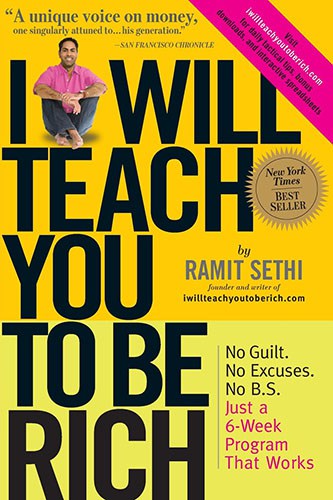I Will Teach You To Be Rich
by Ramit Sethi
Pages: 266
Table of Contents
I Will Teach You To Be Rich Book Review
This book is probably the best personal finance book I’ve ever read. It’s highly specific and action oriented in the right places so it’s not this drawn out encyclopedia of lingo you can’t (and refuse to) understand. I also love that Ramit uses real examples and actual names of companies, banks, and websites. If you can get past the extremely scammy name (and you should quickly) you’ll find this book as much of a gem as I do.
Onward to the Takeaways
“Automatically enable yourself to save, invest, and spend – enjoying it, not feeling guilty…because you’re spending only what you have.” Automatic saving and investing will help overcome psychological barriers and pure laziness, both of which I was guilty of.
Shoot for long-term investing instead of speculative, market-timing investing. It’s better to consistently invest over time than either try to perfectly time it and lose or not invest at all.
It’s better to act and get your finances 85% right than do and get 0%. Sometimes good enough is good enough, and it’s always better than doing nothing.
“Spend extravagantly on the things you love, and cut mercilessly on the things you don’t.” This doesn’t mean be cheap. This is key to living a rich life. Everyone defines a rich life differently.
Money isn’t everything in living a rich life. It’s just the tool to acquire the material possessions and experiences.
Instead of a budget that no one will stick to. Test a Conscious Spending Plan.
The 6-Week Program
- Credit Cards: Check credit score, pick a good card, set up automatic payments, and pay off existing debt.
- Bank Accounts: Either open a new checking account or assess current account.
- Investment Accounts: Open a 401k and research a Roth IRA. Set up automatic payments.
- Conscious Spending: Track spending and cut in right places. Go for big wins first.
- Automatic Money Flows: Keep a list of accounts and link them as necessary. You’ll be setting up an automatic money flow. This funds the 4 categories of your Conscious Spending Plan automatically.
- Investing Choices: Figure out investing style, research investments, and ultimately buy funds.
Personal Finance Ladder by Rung
- Get max company match in 401k.
- Pay off debt.
- Invest in Roth IRA.
- Revisit 401k contribution.
- Invest in other taxable accounts (not retirement accounts).
Recommended Percentages for Conscious Spending Plan
- 50-60% on fixed costs.
- 10% on long-term investments.
- 5-10% on savings goals.
- 20-35% on guilt-free spending.
Investing
- Invest in target-date funds or index funds.
- Invest aggressively in retirement accounts early on.
- Recommended financial institutions: Vanguard, T. Rowe Price, and Schwab.
- Rebalance every 12-18 months by investing more in lower performing assets. Do not sell the higher performing assets.
- Hold tax-inefficient, income-generating assets like bonds in tax-advantaged accounts.
- Hold tax-efficient assets like index funds in taxable accounts.
- Choose funds based on expense ratio, asset allocation, and 10-15 year return.
David Swenson’s Yale Endowment Portfolio
- 30% US stocks
- 15% developed international stocks
- 5% emerging market stocks
- 20% REITs
- 15% government bonds
- 15% TIPS
Houses
- Houses are a poor investment compared to stocks, typically returning 0% after inflation.
- Before buying a house, determine total monthly payment. This includes mortgage, taxes, insurance, and maintenance costs. The total monthly payment should be less than 30% of gross monthly income.
- Total house price should be less than 3x annual gross income.
- Buy a house only if you can live in it for 10 years.
- Make a 20% down payment and get a 30 year fixed-rate mortgage. You can and should pay this down well before the 30 year mark.

